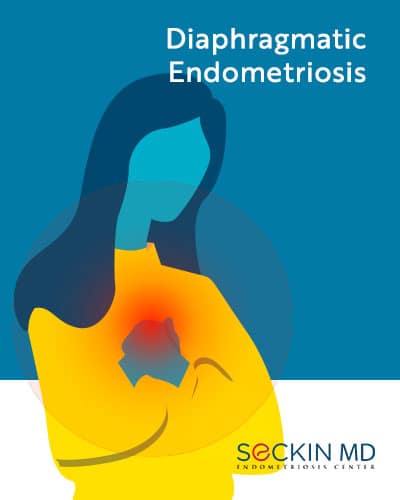
Endometriosis is a chronic, progressive disease characterized by the growth of endometrial-like tissue outside the uterus. These extraneous uterine outgrowths that respond to monthly cycles can occur in several places including the ovaries, fallopian tubes, uterosacral ligaments, and bladder.
Apart from these regions, endometriosis may also rarely occur in areas such as the diaphragm, upper abdominal cavities, and kidneys.
Diaphragmatic endometriosis is a rare condition that occurs in only 1-1.5% of total endometriosis cases. It can also be present alongside thoracic endometriosis (endometriosis inside the chest cavity).
About the diaphragm
The diaphragm is a large, dome-shaped muscle located below the lungs. It separates the thoracic (chest) and abdominal cavities, and its involuntary contraction and relaxation allow us to breathe. The diaphragm has openings that allow important structures such as the esophagus and major blood vessels to pass through.
Get a Second Opinion
Our endometriosis specialists are dedicated to providing patients with expert care. Whether you have been diagnosed or are looking to find a doctor, they are ready to help.Our office is located on 872 Fifth Avenue New York, NY 10065.
You may call us at (212) 988-1444 or have your case reviewed by clicking here.
Causes of diaphragmatic endometriosis
The cause of endometriosis itself is still unclear. However, there are many theories that attempt to explain how the disease may develop. One of these is retrograde menstruation which suggests that menstrual blood containing endometrial cells flows back via the fallopian tubes and is carried to other parts of the body including the diaphragm. Here, the implant starts to grow, forming endometrial lesions. It is likely that a combination of many factors, including genetics, leads to the development of endometriosis.
Symptoms of diaphragmatic endometriosis
Diaphragmatic endometriosis can be asymptomatic. Reported symptoms include pain in the upper right abdominal region, under the lower ribs, and the arm and neck region, which becomes apparent during menstruation.
The chest and abdominal pains could be the result of stimulation of the phrenic nerve during menstruation. The phrenic nerve controls the movement of the diaphragm during breathing.
Other symptoms may include painful breathing, nausea, and vomiting.
Diagnosis of diaphragmatic endometriosis
Since diaphragmatic endometriosis is rare and largely asymptomatic, diagnosis is quite difficult. Complicating the diagnosis is the low sensitivity of imaging techniques and relatively low levels of clinical suspicion by healthcare providers. However, there are several diagnostic methods that can help reach a diagnosis.
- Medical history and physical examination that takes into account the chest and pelvic pain and/or shortness of breath experienced by the patient during menstruation (catamenial chest pain) along with signs of tenderness during a pelvic or rectovaginal exam can be indicative of diaphragmatic endometriosis.
- Inspection of the diaphragm by an endometriosis expert with laparoscopy can help diagnose diaphragmatic endometriosis. Laparoscopy can also reveal endometriosis lesions on the diaphragm surface, indicating that there also may be lesions hiding behind the liver, which shares surfaces with the diaphragm on the right side. Only an experienced endometriosis surgeon can recognize these lesions.
- Magnetic resonance imaging (MRI), along with other imaging techniques such as computerized tomography (CT) and chest X-ray may offer between 78 and 83% sensitivity to diagnose diaphragmatic endometriosis.
Treatment of diaphragmatic endometriosis
Some doctors may prescribe combined oral contraceptives (COCs), progestins, or gonadotropin-releasing hormone (GnRH) agonists to treat the symptoms of endometriosis. However, the use of COCs should be monitored since they have limited applicability and may cause disease progression due to estrogen dominance.
The aim of the treatment should be to remove the endometriotic lesions and thereby provide symptomatic relief and prevent a recurrence. Laparoscopic excision surgery is the gold standard for the treatment of all types of endometriosis.
Patient story

Latia Lee is one of many patients who received a wrong diagnosis. When her pulmonologist finally suspected that her ‘killer cramps’, breathlessness, neck, chest, and shoulder pain could be due to endometriosis, Latia’s instincts led her to believe that these symptoms could be due to diaphragmatic endometriosis and catamenial pneumothorax.
Latia’s subsequent meeting with Dr. Seckin rekindled her hope. Read on to know how Dr. Seckin’s team performed two major surgeries close to one another with immaculate expertise and, in Latia’s own words, “gave her life back” after nearly 20 years of suffering.
Get a Second Opinion
Our endometriosis specialists are dedicated to providing patients with expert care. Whether you have been diagnosed or are looking to find a doctor, they are ready to help.Our office is located on 872 Fifth Avenue New York, NY 10065.
You may call us at (646) 960-3080 or have your case reviewed by clicking here.
Dr. Seckin is an endometriosis specialist and women’s reproductive health advocate. He has been in private practice for over 30 years at Lenox Hill Hospital with a team of highly skilled personnel.
Dr. Seckin specializes in advanced laparoscopic procedures and is recognized for his expertise in complex cases of deep infiltrating endometriosis of the pelvis. He is particularly dedicated to performing fertility-preserving surgeries on cases involving the ovaries.
He has developed patented surgical techniques, most notably the “Aqua Blue Excision” technique for a better visualization of endometriosis lesions. His surgical techniques are based on precision and microsurgery, emphasizing organ and fertility preservation, and adhesion and pain prevention.
Dr. Seckin is considered a pioneer and advocate in the field of endometriosis.
